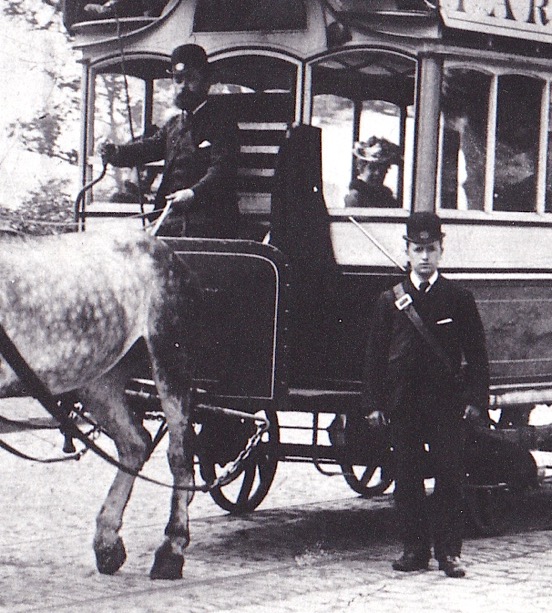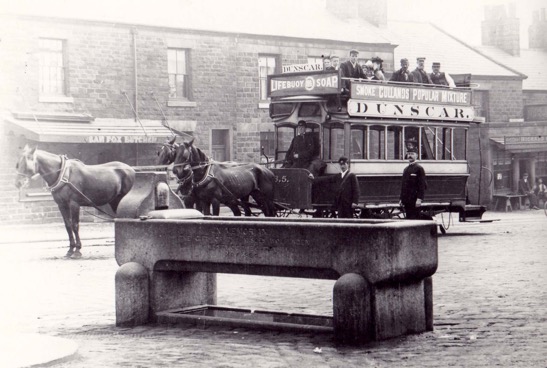Bolton and Suburban Tramways
History
The standard-gauge horse tramway system in Bolton and its environs opened for business on the 1st September 1880; although it was built and owned by several local authorities — Bolton Corporation, and Astley Bridge, Farnworth and Kearsley Local Boards (later Urban District Councils) — operation was leased to a local undertaking, Edmund Holden and Company.
At its greatest extent, the horse tramway system totalled 18 miles, comprising lines: northwards to Dunscar Bridge; southeastwards to Farnworth; southwestwards to Daubhill and Deane; westwards to Lostock; and northwestwards to Doffcocker and Halliwell.
In 1898, the track in Astley Bridge passed into the ownership of Bolton Corporation following the latter's absorption of the former, and in June of the following year — as a prelude to electrification — Bolton Corporation purchased the assets (and remaining leases) of Edmund Holden and Company; the tracks in Farnworth and Kearsley however, remaining in the ownership of the respective UDCs. The horse tramway continued to be worked by Edmund Holden and Company under contract whilst reconstruction for electric working took place, the last horse tram running on the 2nd January 1900.
Uniforms
In common with the majority of horse tramways in the UK, drivers and conductors simply wore informal but smart attire — trousers, jacket, waistcoat, shirt and tie, and a bowler hat. The wearing of the latter — as opposed to another type of hat — was possibly company policy, as staff in all three photos below have them, along with a round, metal badge, presumably issued by the operator, Edmund Holden and Company; the latter was more than likely attached by means of an elasticated band.
The third photo below includes an individual who is in all likelihood an inspector; he is wearing a single-breasted jacket with upright collars, with the latter appearing to carry some kind of designation, most probably the employee's grade (i.e., 'Inspector') or the company's initials. Headgear took the form of a kepi-style cap, which carried a small badge with a protrusion on top, very similar in form to those issued by the North Metropolitan Tramways Company (see link), though much smaller; an example has not survived.
My thanks go to Ted Gray for high resolution copies of the first two photos below, which were first published in his book 'Manchester Road & Rail' (Sutton, 1996).
Further reading
For a short history of Bolton's horse tramways, see: 'Tramways in Bolton' by Tony Young and Derek Shepherd; Light Rail Transit Association (2019).
Images
Horse tram drivers and conductors
A three-horse car (F5; Farnworth Depot) pictured in Manchester Rd on the Farnworth route — photo undated, but from the style of headwear, probably taken between the mid 1880s and mid 1890s. Photo courtesy of Ted Gray.
A blow-up of the above photo showing the conductor (Teddy Whittle) and the driver (Bob ?). Both men are smartly but informally attired, with tall bowler hats and a conspicuous round hat badge, which shows up well photographically, strongly suggesting that it was metal.
A driver, conductor and inspector pose with Horsecar B5 on a Bolton-Dunscar service on Blackburn Rd at its junction with Belmont Rd — photo undated, but probably taken in the mid-1890s. Photo courtesy of Ted Gray.
A blow-up of the above photo showing the driver and conductor. Once again, both men are wearing smart but informal attire, along with bowler hats bearing a round metallic badge.
A conductor and Driver Dick Salkeld pose with Horsecar B8 on the Bolton-Dunscar route at the Gatehouse — photo undated, but probably taken in the mid-to-late 1890s. Photo courtesy of the Tramways and Light Railway Society, with thanks to David Voice.
A blow-up of the above photo, showing the informal but smart attire, squat bowler hats and the round cap badge.
Senior staff
A blow-up of the photo of Horsecar B5 above on Blackburn Rd showing the inspector. He is wearing a single-breasted uniform jacket with upright collars bearing a badge of some kind, very probably embroidered. His kepi-style cap bears a small cap badge with a prominent protrusion at the top, significantly different in form to those worn by the tramcar crews.